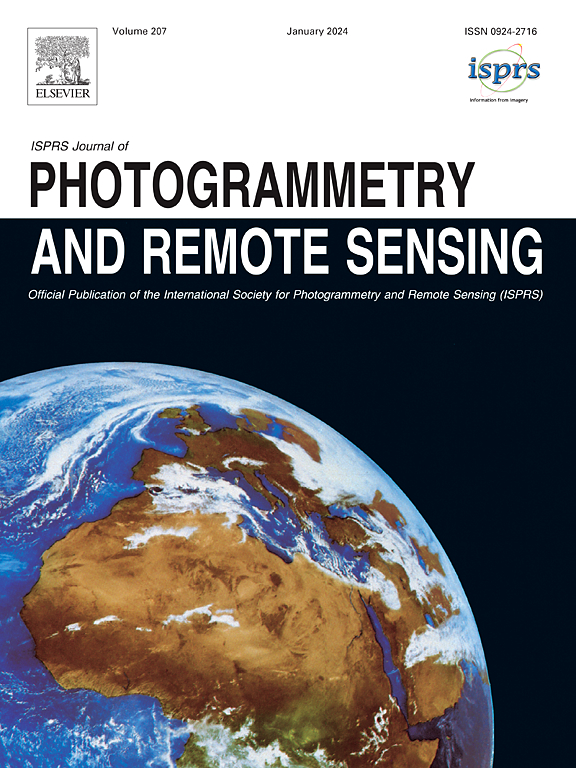利用偏振合成孔径雷达图像时间序列进行水稻自动测绘的不依赖物候知识的方法
IF 10.6
1区 地球科学
Q1 GEOGRAPHY, PHYSICAL
ISPRS Journal of Photogrammetry and Remote Sensing
Pub Date : 2024-10-04
DOI:10.1016/j.isprsjprs.2024.09.035
引用次数: 0
摘要
水稻养活了全球一半以上的人口,因此需要精确高效的测绘来确保粮食安全。合成孔径雷达(SAR)因其在恶劣天气条件下有效工作的卓越能力和对水稻生长的敏感性,已成为这一过程中不可或缺的工具。基于物候知识(PKB)的方法通常与合成孔径雷达图像时间序列结合使用,用于水稻测绘,这主要是因为这些方法无需训练数据集。然而,PKB 方法有其固有的局限性,主要是因为它们依赖于有关水稻生长的精确物候信息。这些信息因地区和水稻品种的不同而各异,因此在大空间尺度(如全国或全球尺度)上有效使用 PKB 方法具有挑战性,因为在这些尺度上收集全面的物候数据是不切实际的。此外,即使在同一地区,耕作方式和田间条件的不同也会导致水稻生长阶段的差异。在 PKB 方法中使用一套通用的物候知识可能并不适用于所有稻田,从而可能导致水稻提取错误。针对 PKB 方法带来的挑战,本研究提出了一种创新方法,即独立于物候知识(PKI)方法,用于利用 Sentinel-1 SAR 图像的时间序列绘制水稻图。PKI 方法的核心创新点在于它无需依赖特定的水稻物候知识或训练数据集即可绘制水稻图。这要归功于三个新指标:VH 和 VV 归一化最大时间变化 (NMTC) 以及 VH 时间平均值,这三个指标是从 SAR 图像时间序列中水稻与其他土地覆被类型的区别中得出的。PKI 方法在中国三个地区进行了严格评估,每个地区都有不同的水稻品种。此外,PKI 方法还与两种常用的基于物候知识的技术进行了比较:利用 SAR 水浸信号的水稻自动绘图方法(ARM-SARFS)和对无监督聚类结果的人工解释(MI-UCR)。PKI 方法的平均总体准确率达到 97.99%,超过了 ARM-SARFS,后者的准确率为 89.65%,原因是不同稻田之间的物候差异造成了误差。此外,PKI 方法与 MI-UCR 方法的结果相当,后者依赖于合成孔径雷达和光学图像时间序列的融合,准确率达到 97.71%。这些研究结果表明,PKI 方法在绘制不同地区的水稻地图时非常有效,而且无需物候知识或训练数据集。因此,该方法有望在大空间尺度上高效绘制水稻图谱。本研究使用的源代码可在 https://code.earthengine.google.com/f82cf10cad64fa3f971ae99027001a6e 上获取。本文章由计算机程序翻译,如有差异,请以英文原文为准。
A phenological-knowledge-independent method for automatic paddy rice mapping with time series of polarimetric SAR images
Paddy rice, which sustains more than half of the global population, requires accurate and efficient mapping to ensure food security. Synthetic aperture radar (SAR) has become indispensable in this process due to its remarkable ability to operate effectively in adverse weather conditions and its sensitivity to paddy rice growth. Phenological-knowledge-based (PKB) methods have been commonly employed in conjunction with time series of SAR images for paddy rice mapping, primarily because they eliminate the need for training datasets. However, PKB methods possess inherent limitations, primarily stemming from their reliance on precise phenological information regarding paddy rice growth. This information varies across regions and paddy rice varieties, making it challenging to use PKB methods effectively on a large spatial scale, such as the national or global scale, where collecting comprehensive phenological data becomes impractical. Moreover, variations in farming practices and field conditions can lead to differences in paddy rice growth stages even within the same region. Using a generalized set of phenological knowledge in PKB methods may not be suitable for all paddy fields, potentially resulting in errors in paddy rice extraction. To address the challenges posed by PKB methods, this study proposed an innovative approach known as the phenological-knowledge-independent (PKI) method for mapping paddy rice using time series of Sentinel-1 SAR images. The central innovation of the PKI method lies in its capability to map paddy rice without relying on specific knowledge of paddy rice phenology or the need for a training dataset. This was made possible by the incorporation of three novel metrics: VH and VV normalized maximum temporal changes (NMTC) and VH temporal mean, derived from the distinctions between paddy rice and other land cover types in time series of SAR images. The PKI method was rigorously evaluated across three regions in China, each featuring different paddy rice varieties. Additionally, the PKI method was compared with two prevalent phenological-knowledge-based techniques: the automated paddy rice mapping method using SAR flooding signals (ARM-SARFS) and the manual interpretation of unsupervised clustering results (MI-UCR). The PKI method achieved an average overall accuracy of 97.99%, surpassing the ARM-SARFS, which recorded an accuracy of 89.65% due to errors stemming from phenological disparities among different paddy fields. Furthermore, the PKI method delivered results on par with the MI-UCR, which relied on the fusion of SAR and optical image time series, achieving an accuracy of 97.71%. As demonstrated by these findings, the PKI method proves highly effective in mapping paddy rice across diverse regions, all without the need for phenological knowledge or a training dataset. Consequently, it holds substantial promise for efficiently mapping paddy rice on a large spatial scale. The source code used in this study is available at https://code.earthengine.google.com/f82cf10cad64fa3f971ae99027001a6e.
求助全文
通过发布文献求助,成功后即可免费获取论文全文。
去求助
来源期刊

ISPRS Journal of Photogrammetry and Remote Sensing
工程技术-成像科学与照相技术
CiteScore
21.00
自引率
6.30%
发文量
273
审稿时长
40 days
期刊介绍:
The ISPRS Journal of Photogrammetry and Remote Sensing (P&RS) serves as the official journal of the International Society for Photogrammetry and Remote Sensing (ISPRS). It acts as a platform for scientists and professionals worldwide who are involved in various disciplines that utilize photogrammetry, remote sensing, spatial information systems, computer vision, and related fields. The journal aims to facilitate communication and dissemination of advancements in these disciplines, while also acting as a comprehensive source of reference and archive.
P&RS endeavors to publish high-quality, peer-reviewed research papers that are preferably original and have not been published before. These papers can cover scientific/research, technological development, or application/practical aspects. Additionally, the journal welcomes papers that are based on presentations from ISPRS meetings, as long as they are considered significant contributions to the aforementioned fields.
In particular, P&RS encourages the submission of papers that are of broad scientific interest, showcase innovative applications (especially in emerging fields), have an interdisciplinary focus, discuss topics that have received limited attention in P&RS or related journals, or explore new directions in scientific or professional realms. It is preferred that theoretical papers include practical applications, while papers focusing on systems and applications should include a theoretical background.
 求助内容:
求助内容: 应助结果提醒方式:
应助结果提醒方式:


